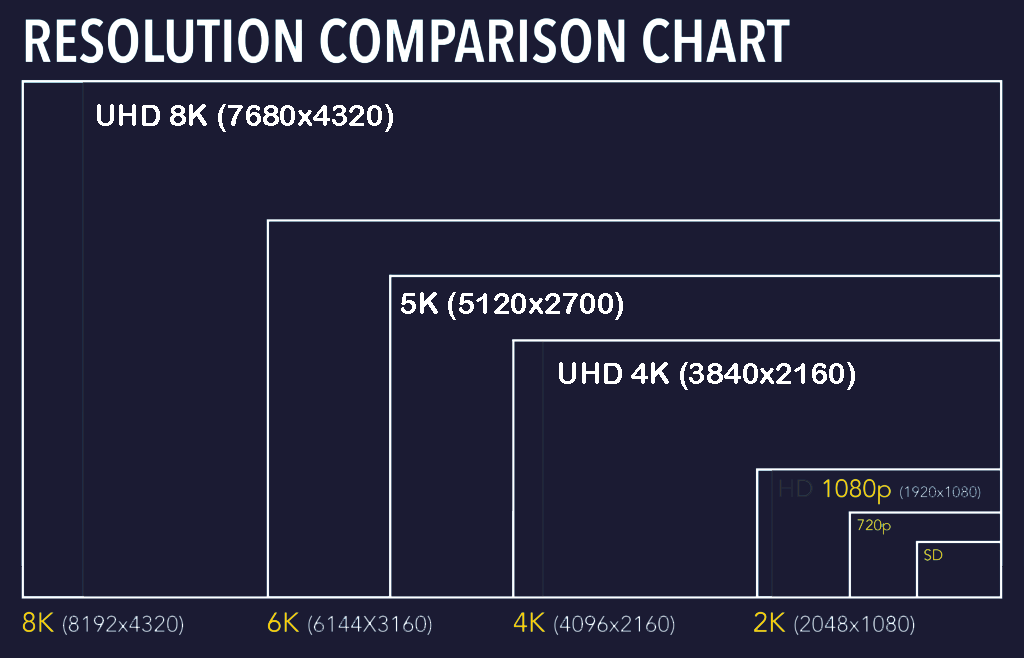4k Resolutions, Resolution measures the number of pixels in a digital image or display. It is defined as width by height, or W x H, where W is the number of horizontal pixels and H is the number of vertical pixels. For example, the resolution of an HDTV is 1920 x 1080.

What is resolution explain?
In computers, the resolution is the number of pixels (individual points of color) contained on a display monitor, expressed in terms of the number of pixels on the horizontal axis and the number on the vertical axis. Typically, PC monitors have somewhere between 50 and 100 pixels per inch.
What does 4K and 6K mean?
A. 0-9. Approximately 6,000 (6K) pixels of horizontal resolution. Although 4K TVs have become mainstream, it remains to be seen whether a 6K TV will be forthcoming to bridge the gap between 4K and 8K, the latter prohibitively expensive as of 2020
What is 4K resolution size?
“4K” refers to horizontal resolutions of around 4,000 pixels. The “K” stands for “kilo” (thousand). As things stand, the majority of 4K displays come with 3840 x 2160 pixel (4K UHDTV) resolution, which is exactly four times the pixel count of full HD displays (1920 x 1080 pixels).
Which is better UHD or 4K?
This abbreviation stands for Ultra High Definition and is the successor to Full HD. The resolution of UHD is 3840 x 2160 pixels (8,294,400 pixels overall), which is four times higher than that of its predecessor. 4K refers to a horizontal resolution of 4096 Pixels (4K = 4000).
So why have it?
What most people don’t realize is that 4K and higher shooting formats are used for purposes of editing, where you may need to zoom in on an image without any resolution loss. Yes, the higher number equals more pixels.
Shooting 4K will make your HD video look better. Most HD cameras today capture great quality 1080p video, but when you start with 4K source material and downscale it to HD resolution the picture will look even better, thanks to effectively oversampling each pixel by a factor of four.
Display resolution is not measured in dots per inch as it usually is with printers. However, the resolution and the physical monitor size together do let you determine the pixels per inch. Typically, PC monitors have somewhere between 50 and 100 pixels per inch. For example, a 15-inch VGA (see display modes) monitor has a resolution of 640 pixels along a 12-inch horizontal line or about 53 pixels per inch. A smaller VGA display would have more pixels per inch.
What is Resolution in Computer Programming
Resolution measures the number of pixels in a digital image or display. It is defined as width by height, or W x H, where W is the number of horizontal pixels and H is the number of vertical pixels. For example, the resolution of an HDTV is 1920 x 1080.
What is the resolution in computer?
In computers, the resolution is the number of pixels (individual points of color) contained on a display monitor, expressed in terms of the number of pixels on the horizontal axis and the number on the vertical axis. … Display resolution is not measured in dots per inch as it usually is with printers.
What is called resolution?
Resolution is the image quality produced by a printer or displayed on a monitor. With monitors, the resolution is measured by the number of pixels horizontal by pixels vertically. Printers also have a measure of resolution called DPI (dots per inch).
What is meant by resolution of a screen?
Monitor resolution describes the visual dimensions of any given display. Expressed in terms of width and height, monitor resolution is comprised of a specific number of pixels. … This means that the screen will have a width of 1,920 pixels while the height of the screen will be 1,080 pixels.
4k Resolutions, the new trend in Computer Graphic engineers circle.
Happy Designing 🙂